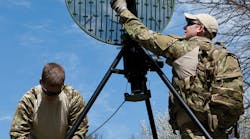DoD Adds Second Ovzon Mobile Satellite Terminal
The U.S. Dept. of Defense placed a second order with Ovzon for the industry’s smallest, lightest, and fastest mobile satellite terminal, the Ovzon T7. Earlier this year (February), the DoD placed the first order for the satellite terminal which teams with the firm’s Ovzon 3 satellite to support critical communications in contested environments. The satellite began active duty on July 5, 2024.
Ovzon’s chief executive officer (CEO), Per Norén, commented: “We are delighted to see this additional order for Ovzon T7 from such an important and valued customer. We consider this a significant vote of confidence that the powerful combination of the Ovzon T7 terminal and the Ovzon 3 satellite is exceeding expectations for performance, mobility, and resiliency.”
The Ovzon T7 terminal (see figure) provides transmissions speeds of 10 MB/s and reception rates to 60 Mb/s. It measures 7.9 × 7.1 × 3.01 in. (202 × 179 × 78 mm) and weighs 6.2 lb. (2.8 kg). The compact satcom terminal is designed for use from -25 to +55°C (-13 to +131°F) and consumes 65 W from a +24-VDC supply.




